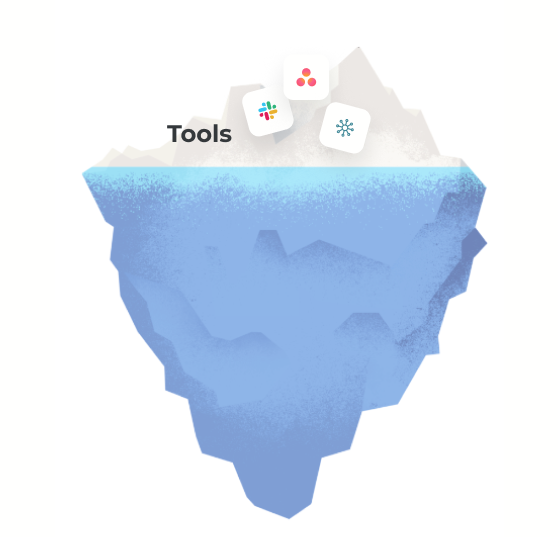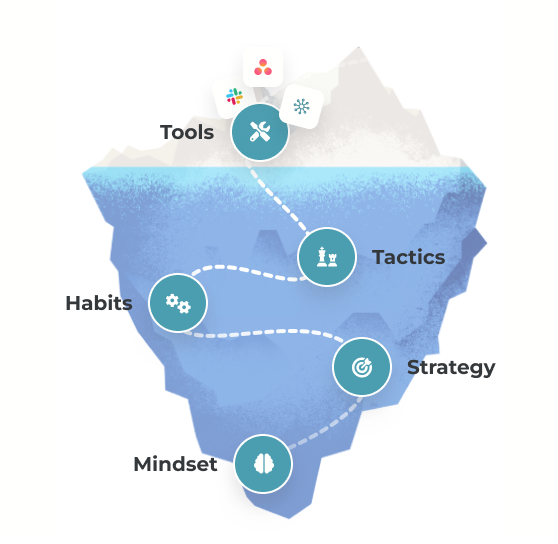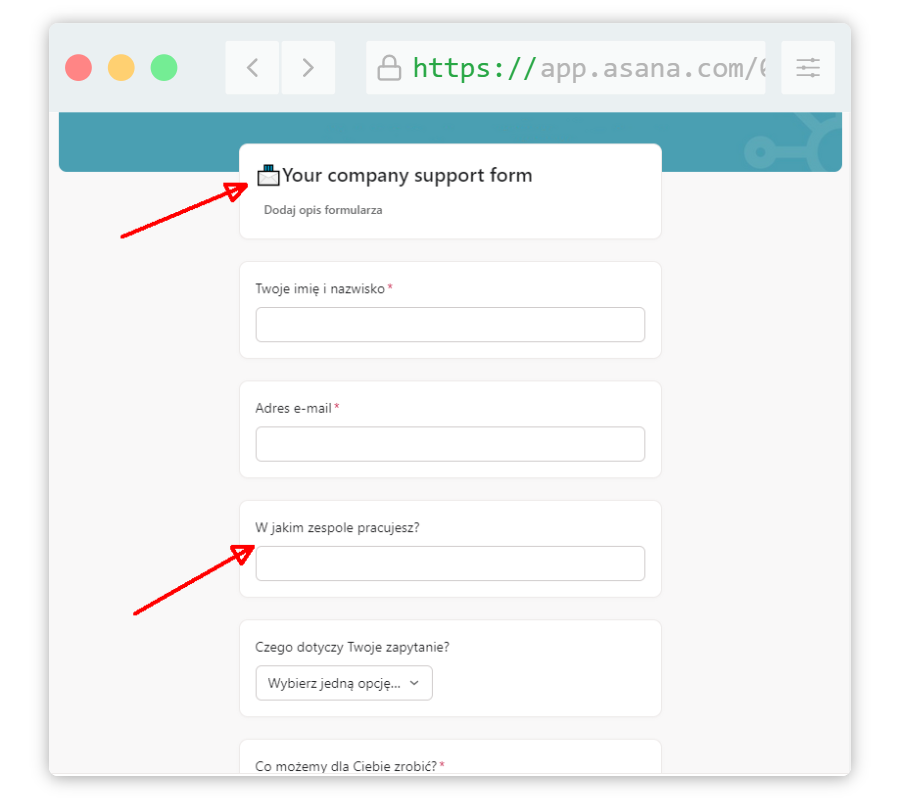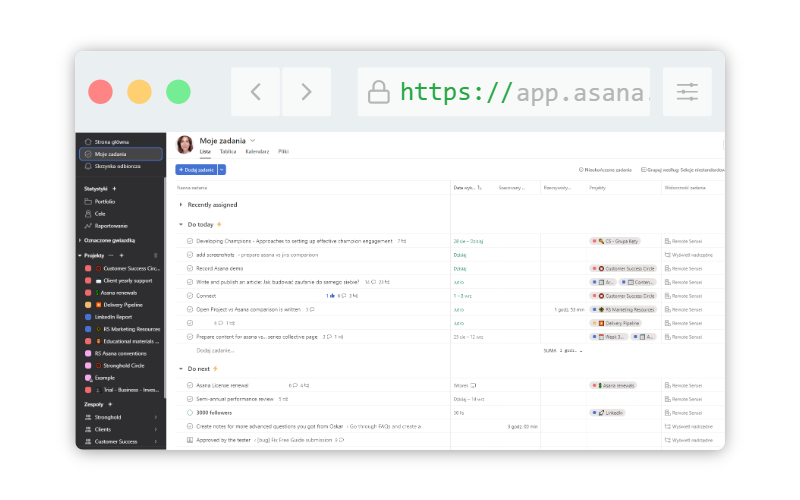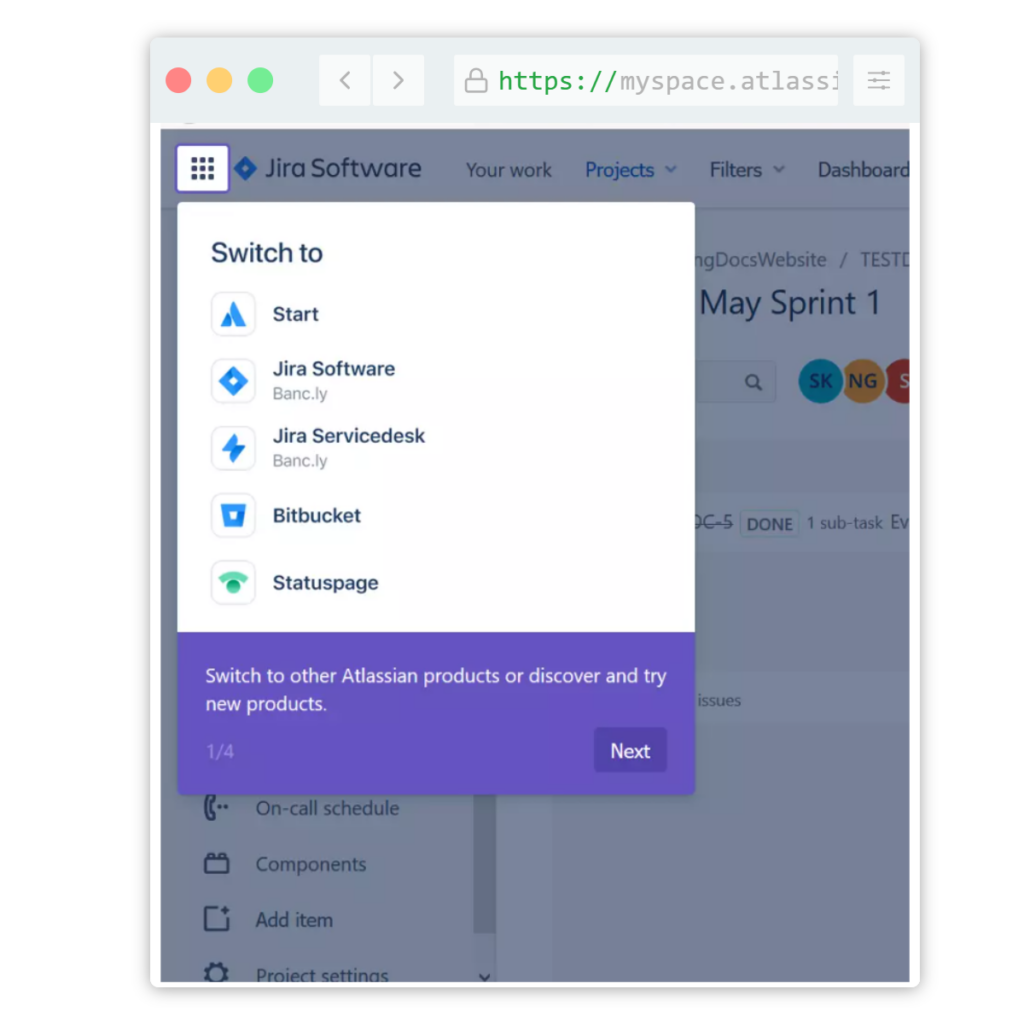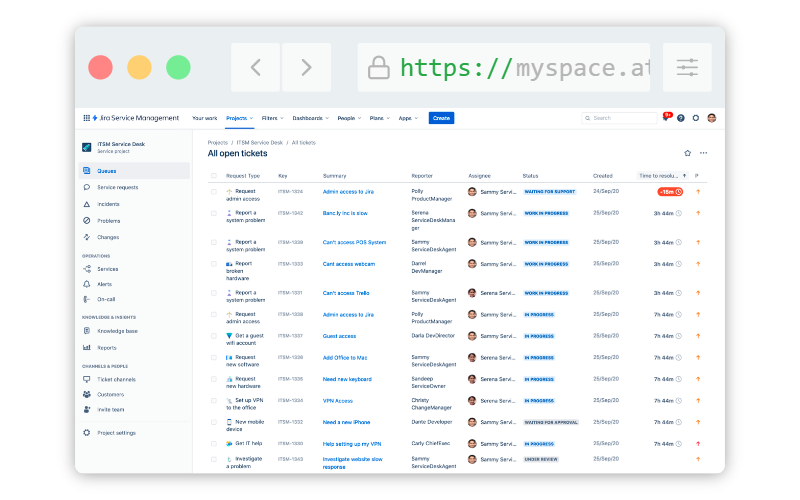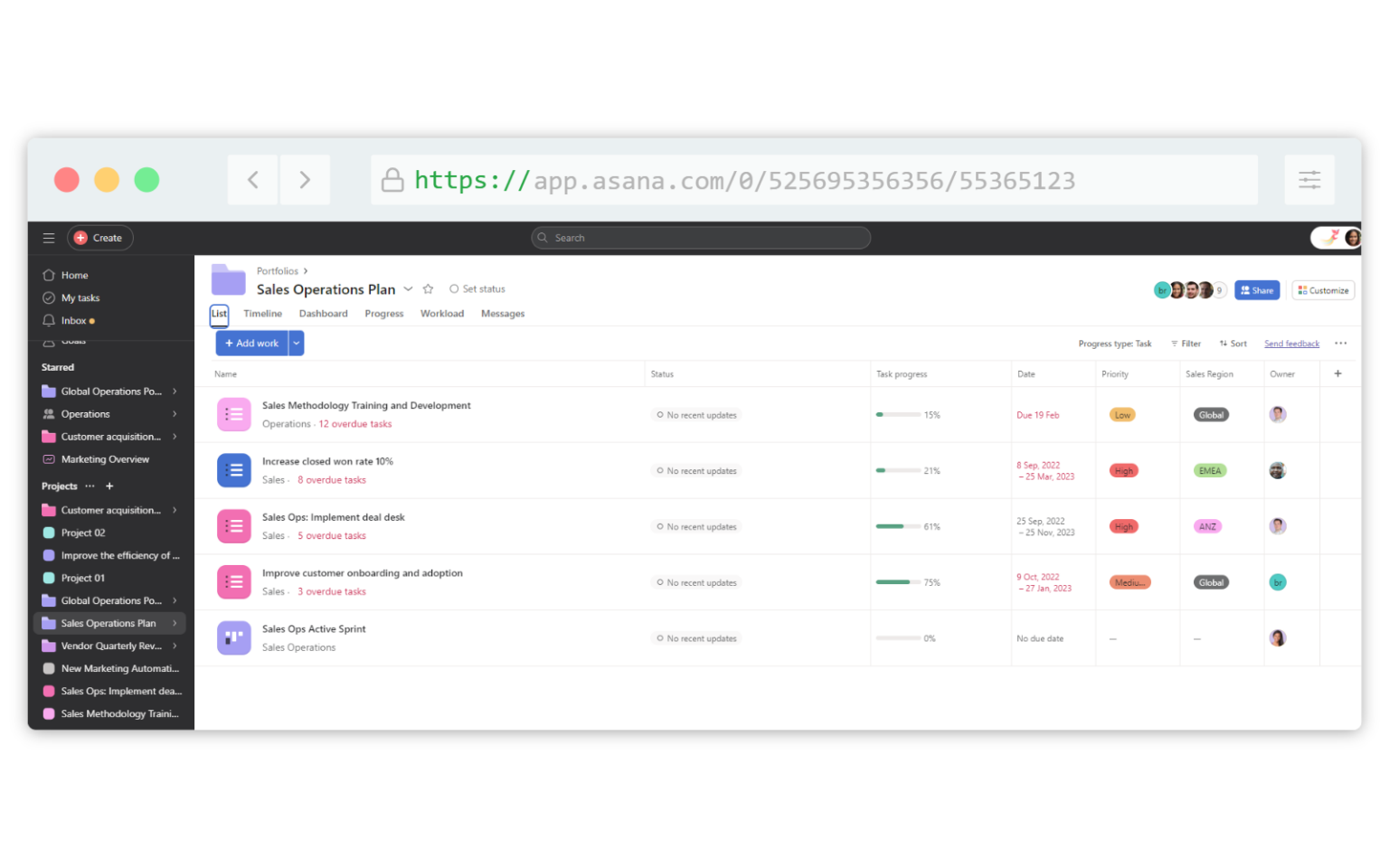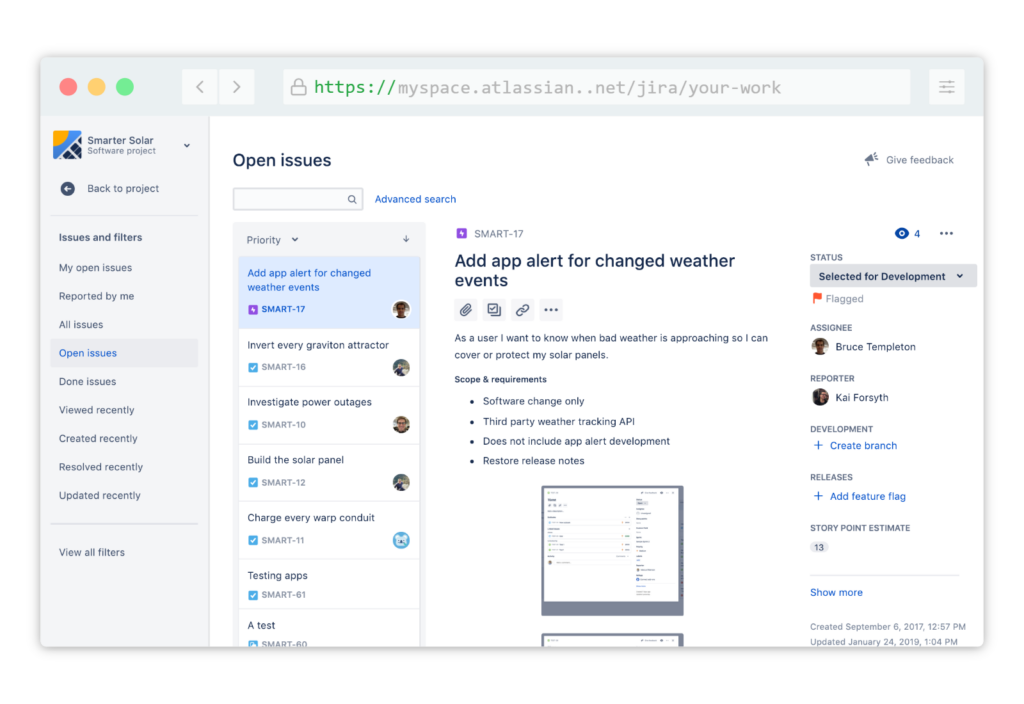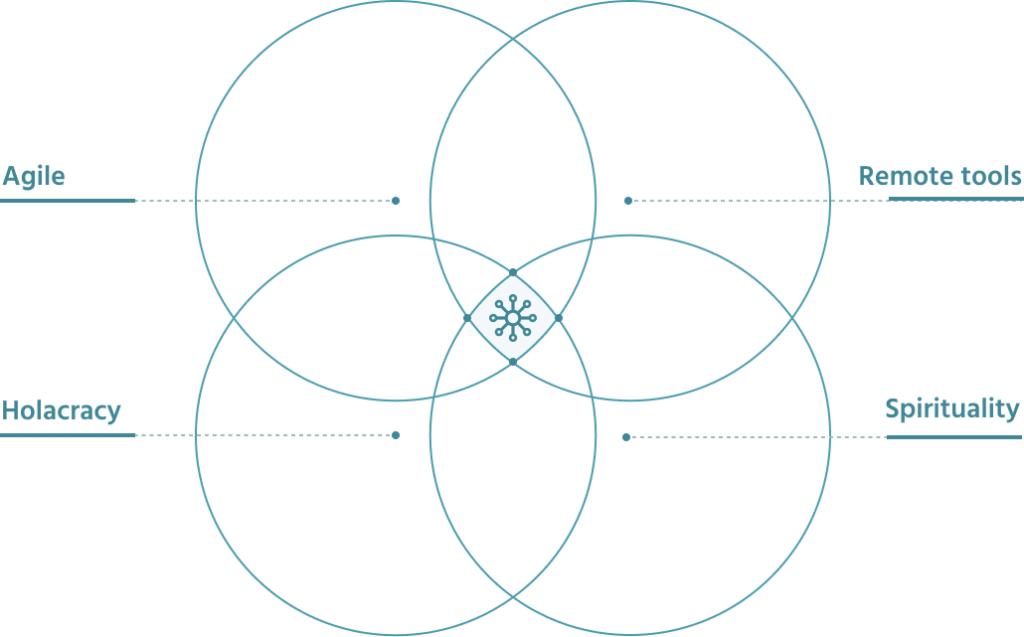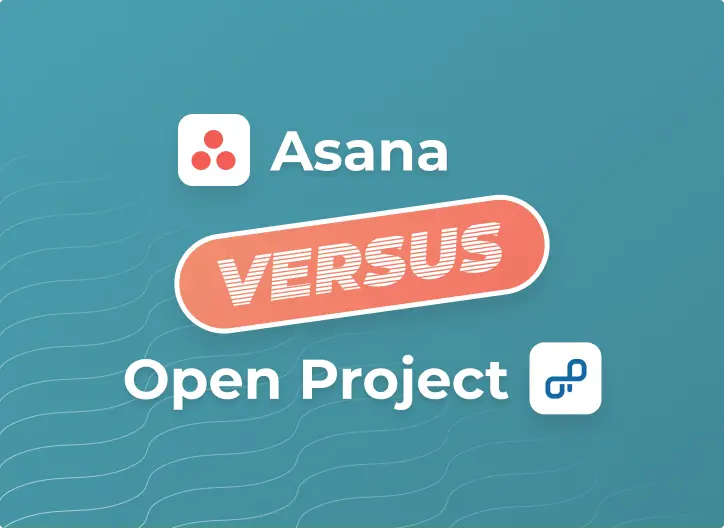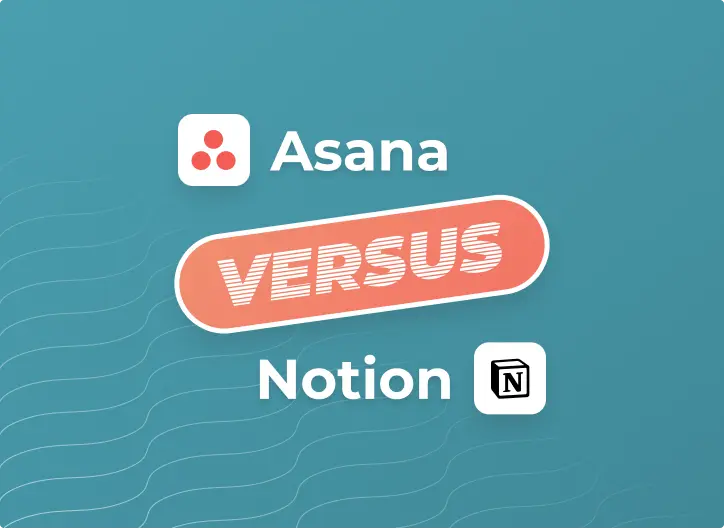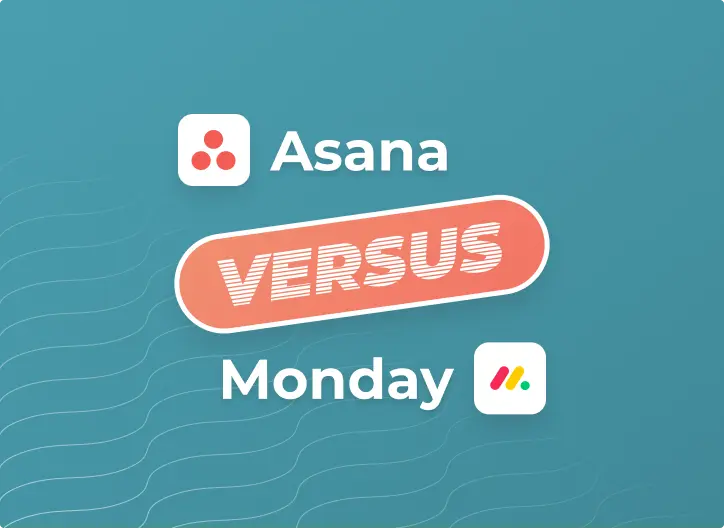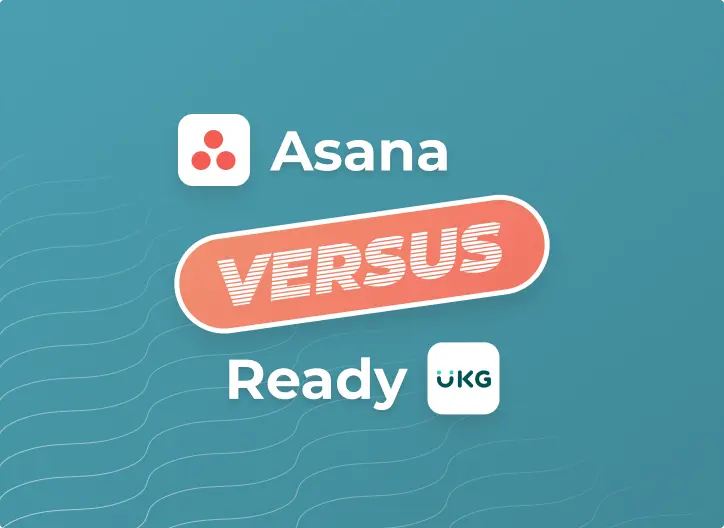What should guide you when choosing an organisational management application?
What should guide your choice of organisational management app?
The right question you should ask yourself is: will people use it?
If so, ask: For how long?
In fact, tools are just the tip of the iceberg:
The platform is part of a whole work system (iceberg) in which all aspects are equally important. And it is these invisible layers that affect how your team and ultimately the whole organisation works together.
Your work system consists of:
Comprehending this is key to realising the full potential of the team and to creating an environment where all these elements are in harmony with each other.
This is the conclusion I and the other consultants we currently work with have come to.
If you need
Planes of comparison,
here they are:
Integrations with other tools
- Asana: wins by the number and the way it integrates with other tools for working in teams.
- Jira: favours integrations related to software development, which can already be seen from the integration categories (e.g. deployments, code review, integrations related to code repositories, etc.) Many functionalities native to Asana, but useful for non-development teams, have to be provided in Jira by external applications.
Customer support
- Asana : offers faster support, including a Polish version with a dedicated partner (i.e. us ). Response times for both Asana and Remote Sensei support are a few hours for most requests. Our customers receive a dedicated request form for support and a dedicated team of technical experts.
- Jira: response time is, depending on the type of request, up to 2 working days. No dedicated forms or experts.
User interface
- Asana: It has an intuitive and aesthetically pleasing interface, characterised by simplicity and ease of use. It is a tool focused on flexibility and intuitiveness. The application is divided into a sidebar and a central section, allowing a unified view of teams and projects and easy access to goals, portfolios and reports, which cannot be said of Jira. Asana also has a feature called inbox, which allows team members to communicate within Asana, offloading internal communication to other tools.
- Jira: It is more complex, especially for new users. Jira’s interface is more technical and requires a lot of skill to navigate the tool smoothly. Jira offers advanced configuration features, which, without knowing it very well, is difficult, especially for new users. Jira lacks functionality to enable communication.
Project and task management
- Asana: One of the few work management tools on the market that, it scales with project and organisational growth. It can meet the needs of both an individual needing a free checklist or a team of a few people, but can also integrate the work of a multinational corporation of thousands of people, in 1 place. Projects are easy to configure and adapt to the needs of different types of teams.
- Jira: Officially designed as an issue tracking tool for software projects, but later extended to project management. Due to the multitude of Atlassian products: Jira Software, Jira Work Management, Jira Service Management, Jira Product Discovery and the need to switch between them using the Atlassian Switcher, using Jira and configuring it properly is complicated. Many functionalities have gradations (basic, standard) depending on the product and plan, further complicating the use of Jira. The automations themselves are divided into global, multi-project and single-project.
Project types
- Asana: Designed from the outset to manage projects of different types and tasks of different nature, making it ideal for sales, marketing, graphic design and UX teams, procurement, HR, customer service, IT support. Tasksin Asana, do not bear the hallmarks of a queuing system and are universal in nature. The dashboard view shows a preview of the graphic material attached to the tasks.
- Jira: Initially designed for programming-related projects such as bug tracking. As the product has evolved, it has been adapted to handle different types of projects, but the ticketness of Jira is very noticeable. Tasks are requests and are placed in so-called queues. Due to its technical nature, Jira is poorly suited for creative teams (marketing, design, UX/UI) and its functionalities are not adapted to work with, for example, graphics, visual materials ( in the whiteboard view, images attached to submissions are not visible). Most of Jira’s functionalities are related to ticket handling of technical incidents in IT projects, which are not useful for other types of projects (e.g. incident investigation view, sandbox, release paths).
Price
- Asana: Offers simple pricing models based solely on the number of users. Asana’s first paid plan, or Premium, includes most of the functionality that is not available in the equivalent Jira plan. In relation to the available functionalities, Asana is cheaper per user. The calculation of the price per number of Asana users per plan is very simple.
- Jira: It has complex pricing models, with the option to pay per user or per instance, depending on the version and products (Jira Software, Jira Work Management, Jira Service Management), but also depending on the data space, which creates a complex web of dependencies and usage limits. Many functionalities, such as resource and configuration management, are only available in a higher plan than the first paid plan.
Adaptation time to new environment and learning curve
- Asana: The adaptation time is much shorter because it is a tool focused on project management. However, it still allows you to create views that are useful for managerial (management, C-suite) and creative (graphic designers, engineers, developers) roles. Mapping processes to Asana is much faster than other tools. It is focused in its philosophy and interface on project and work management so that it is intuitive and as easy to use as possible. During implementation, Asana initially allows you to use only some of the functions. As you become more familiar with the interface, more can be added from higher price plans. The level of complexity of the information architecture is low, but can be increased as the organisation and user experience grows.
- Jira: Due to its complexity and technical nature, creating an optimal working environment is difficult to master and configure, making it time-consuming to adapt Jira to the needs of different teams and very difficult or impossible to map many processes, such as sales or supplier management.
Sustainability of tool use
- Asana: Due to its versatile, simple yet feature-rich nature, the rate of full use of Asana is high. The majority of our customers use Asana at least 60% of the time, and the duration of use is calculated in years. Asana Inc. can prove successful, sustainable implementations in a variety of industries: e-commerce, marketing, the travel industry, real estate and many others.
- Jira: Due to its complexity and adaptation to software development and maintenance projects of already developed systems, the adaptation of Jira brings value mainly in teams handling requests, while sales, marketing, project teams are forced to support themselves with other work management tools anyway.
For a full comparison, we are still left with…
Why did we choose Asana?
Before we decided to implement Asana in organisations, we tested a beta version of it in 2011. This was not the only software we reviewed in parallel and periodically we continue to do so. 12 years later, we still consider Asana to be the best tool for managing the work of both small and large organisations.
The maturity of Asana, the number of possible integrations, and the extreme ease of deployment and remaining at the heart of communication within teams, led us to choose this tool as the foundation of the Remote Sensei framework:
Asana, on the other hand, is only one part of the whole jigsaw of an efficient organisation. We see the potential that teams gain with its introduction.
What’s more, we participate in the regular support of more than 80 organisations that have already implemented it with our help.
Asana perfectly initiates a change in habits and thinking about goals, projects and tasks.
Therefore, at Remote Sensei, we combine the hard skills of using Asana’s functionality with team members’ soft skills such as self-organisation, life and work balance and building co-responsibility among employees.
Ultimately, together with Asana, we impart project management experience, restore the desire for action and ultimately create an environment that is ‘easy to work in’.
Wondering If Asana Fits Your Company?
Differences in functionality between Asana and Jira
| Asana | Jira | |||
| BASIC VIEWS | ||||
| goals | ✅ | ❌ | ||
| project portfolios | ✅ | ❌ | ||
| PROJECT MANAGEMENT | ||||
| templates for recurring projects | ✅ | ❌ | ||
| monitoring of KPIs/OKRs | ✅ | ❌ | ||
| acceptance paths for the various project elements | ✅ | ❌ | ||
| project statuses | ✅ | ❌ | ||
| TASK MANAGEMENT | ||||
| milestones | ✅ | ❌ | ||
| recurring dates with auto-renewal of tasks | ✅ | ❌ | ||
| COMMUNICATION | ||||
| inbox | ✅ | ❌ | ||
| templates for recurring tasks | ✅ | ❌ | ||
| messages for each project | ✅ | ❌ | ||
| ADDITIONAL FEATURES | ||||
| measuring task time | ✅ | ❌ | ||
| report creator | ✅ | ❌ | ||
| CRM/Customer database | ✅ | ❌ | ||
| attachments and images in the board view | ✅ | ❌ | ||
| information on user leave | ✅ | ❌ | ||
| interface customisation | ✅ | ❌ | ||
| user session length management | ❌ | ✅ | ||
| sandbox environment | ❌ | ✅ | ||
| release control | ❌ | ✅ | ||
| history of changes | ✅ | ❌ | ||
| 2-step login | ✅ | ❌ | ||
| customer login as a guest | ✅ | ❌ | ||
| monitoring project progress without an account in the tool | ✅ | ❌ | ||
